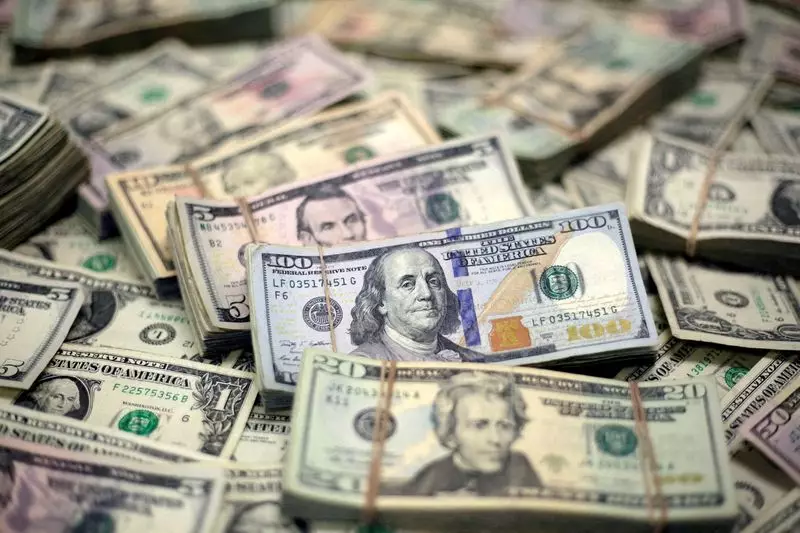In the world of forex trading, the U.S. dollar has recently emerged as a formidable player against major currencies, climbing to a height not witnessed in over two months. This rise is chiefly driven by expectations that the Federal Reserve may implement careful rate cuts in the near future. Enhanced by a string of resilient economic data from the United States, the dollar’s strength is a multifaceted phenomenon reflecting both domestic economic conditions and fluctuating global market sentiments.
Recent statistics suggest that although there is a slight slowing in the U.S. economy, it continues to demonstrate a remarkable degree of resilience. One of the key factors contributing to this scenario is the uptick in inflation for September, which surpassed trader expectations, thereby causing a revision of forecasts regarding aggressive rate cuts by the Fed. While a 50 basis point cut was executed at the last meeting in September, traders now assign an impressive 89% probability to a more modest 25 basis point cut in November. This equates to a potential easing of approximately 45 basis points for the remainder of the year.
The dollar index, which gauges the performance of the U.S. dollar against six major currencies, recently registered at 103.18—a rise of 2.5% that places it close to breaking a three-month trend of decline. Notably, the dollar’s ascent is reinforced by statements from Fed Governor Christopher Waller, advocating for measured caution regarding future rate cuts, spurred on by the current economic indicators. His assertions highlight the volatility remaining within the job market, which is anticipated to undergo distortions due to recent natural disasters and strikes.
The Yen’s Struggles and the Bank of Japan’s Dilemma
In stark contrast to the dollar’s buoyancy, the Japanese yen seems to be facing consistent weakness. It is edging closer to the psychologically significant threshold of 150 yen to the dollar. The depreciation of the yen is largely a response to the recent dovish pivot from the Bank of Japan’s governing body, particularly under the leadership of Governor Kazuo Ueda and the surprising stance taken by newly appointed Prime Minister Shigeru Ishiba against further rate hikes.
Recent trading sessions highlight this currency pressure. Early reports indicated the yen was trading at 149.55 per dollar, having peaked at a 2.5 month high of 149.98 just prior. This period of flux serves to underscore market anxieties regarding Japan’s potential for policy tightening, with a lingering question around when the central bank might contemplate such actions. The yen’s challenges are compounded by the Fed’s hawkish undertones, leaving the yen vulnerable to further declines unless substantial policy shifts occur.
Looking towards Europe, the euro appears anchored near its lowest level since early August, reflecting ongoing uncertainty ahead of the European Central Bank (ECB) policy meeting scheduled for Thursday. Market analysts are bracing for yet another interest rate cut from the ECB, which would further influence currency dynamics across the continent. With the euro currently valued around $1.090825, traders are eyeing comments and actions from the ECB closely, considering how they might impact the euro’s standing against the dollar.
The outlook for the euro remains cautious as investors navigate anticipated shifts in monetary policy and their implications for inflation and growth within the Eurozone. Additionally, apprehension surrounding economic conditions in Europe adds to the pressure faced by the euro, drawing a stark resemblance to the troubles encountered by the yen.
Finally, China’s fiscal policy also plays a crucial role in shaping global currency trends. Recent reports suggest that China may seek to raise an additional 6 trillion yuan ($850 billion) through Treasury bonds to stimulate a faltering economy. Such moves could have ripple effects across Asia and bolster the offshore yuan, which has remained relatively stable around 7.0935 per dollar. Analysts are watching for fresh fiscal stimulus that may emerge during the upcoming meetings in China, signaling further developments that could significantly influence regional currencies.
The current state of the forex market is characterized by multifaceted dynamics with significant interplay between the U.S. dollar’s strength, the yen’s vulnerabilities, and the euro’s uncertainties, against the backdrop of potential fiscal maneuvers from China. As traders and analysts work to predict future movements, ongoing monetary policies from central banks will remain paramount in shaping market trajectories by paving the path for the currencies involved.

